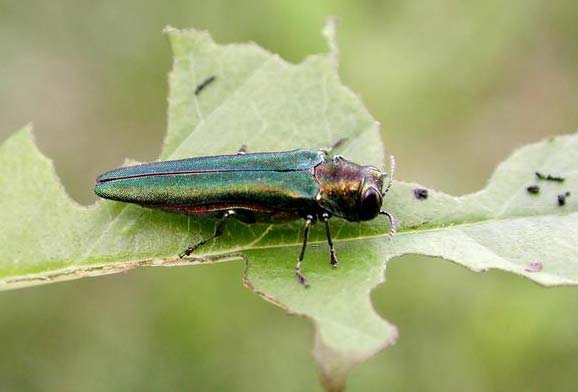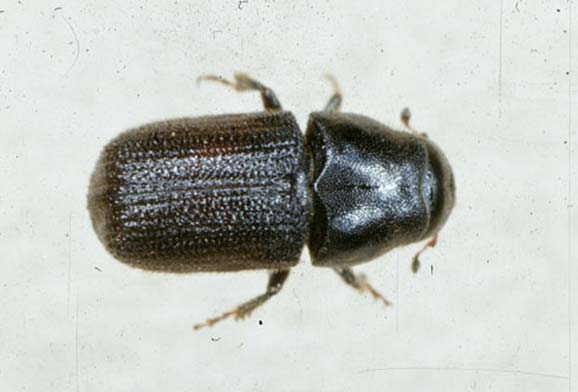The Emerald Ash Borer
What is an Emerald Ash Borer (EAB)?
The EAB is an exotic wood boring beetle (1/2 inch long, dark metallic green) from Asia, which was discovered in Michigan in 2002. Since its discovery in the mid-west, it has been responsible for the death and removal of millions of native Ash trees within the eastern half of the US and Canada. After hatching on the bark surface, the larvae tunnel through the bark and begin consuming the sapwood of various Ash tree species. They feed on the vascular tissue of the tree, producing galleries that girdle & ultimately kill the tree within 3-5 years. **It is expected that EAB will ultimately kill almost every unprotected Ash tree growing in North America – Colorado State University Click here to learn more about EAB

Emerald Ash Borer in Colorado
Emerald Ash Borer – Debbie Miller, USDA Forest Service, Bugwood.org
Symptoms of EAB:
- Thinning canopy
- Branch dieback
- Epicormic (heavy) sprouting
- Vertical cracks in the bark
- Profuse suckering at the lower portions of the trunk
- D-Shaped exit holes
- Excessive wood pecker holes
The Rocky Mountain Pine Beetle
Quick Facts About The Mountain Pine Beetle:
- Mountain Pine Beetles (MPB) are killing trees (Pines and Spruce) through the Rocky Mountain Region and the Western United Stated at an extraordinary rate.
- MPB typically complete their life cycles in two years, but warmer temperatures are allowing life cycles to be completed in one year. Rising temperatures are also allowing beetles to survive the winter.
- MPB prefer forests that are old and dense
- Trees that are not growing rapidly whether it is due to drought, crowding, old age or some other reason are most likely to be attacked by the MPB
- The large amounts of dead trees resulting from this epidemic are creating severe fire hazards.
- Stressed Pine trees with diminishing growth habits, whether due to drought, crowding, maturity or some other natural cause are more likely to be attacked by the MPB.
 Mountain Pine Beetle – USDA Forest Service – Region 2 – Rocky Mountain Region , USDA Forest Service, Bugwood.org
Mountain Pine Beetle – USDA Forest Service – Region 2 – Rocky Mountain Region , USDA Forest Service, Bugwood.orgInfested Trees:
- If you notice popcorn-shaped masses of resin, often referred to as “pitch tubes” on the trunk of your tree, the beetles have begun tunneling.
- If the foliage is turning yellow or reddish through the entire tree crown, your tree may have been attacked by MPB.
- Once your tree has been infested with MPB, not much can be done to save the tree.
- With the current conditions, enough beetles can emerge from an infected tree to kill at least two, maybe more, trees the following year.
- The MPB infestation cannot be stopped.
Prevention:
- Creating diversity (both age and structure) will result in a healthier forest that will be more resilient and less vulnerable to MPB.
- Contact a local forester or ISA Certified Arborist to discuss options and the best forest management practices.
The Mountain Pine Beetle infestation is continuing to increase across Colorado and into parts of Wyoming with over 1 Million acres currently being affected by this epidemic. The MPB is a native to the forests within the Western parts of North America and when outbreaks occur it can result in the loss of millions of trees. Beetle-killed trees can negatively affect things such as watersheds, wildlife habitats, transmission lines, scenic views, recreation sites and timber production, but it also presents the opportunity for fuels to build-up that could potentially cause disastrous forest fires.
If you suspect MPB has infested trees on your property, contact Splintered Forest today at 303-819-9840 to setup a free consultation. Our ISA Certified Arborists will create an individualized plan to assist with your MPB problem.
The Spruce Beetle
The Spruce Beetle is a native species in the spruce forest ecosystem in Colorado and is responsible for the death of more spruce trees in North American than any other natural agent. Their populations can range from Alaska and Newfoundland and South to Arizona and New Mexico. In Colorado, they are typically observed in spruce forests at higher elevations (above 9,000 feet). They tend to infest downed and large, mature trees (16 inches in diameter or more) when the populations are low, but when they reach epidemic levels, they may attack standing and smaller trees.

Signs & Symptoms of an Infestation
- Needles will slowly fade to a pale yellowish-green color before they turn grey
- Light redish-brown boring dust accumulating in the bark crevices and around the base of the tree
- Strings of resin that look similar to candle wax (pitch streamers) which generally can be seen higher on the trunk
- Small, round holes in the bark of the infested tree
- Evidence of increased woodpecker activity
Prevention
One of the most effective ways of mitigating a threat of a spruce beetle outbreak is to manage the overall health of your forest. Creating both age and species diversity will help support the forest health and reduce the impacts of a future attack. Removing downed spruce can also help maintain beetle populations.
There are other treatment options, but should be discussed with an ISA Certified Arborist before taking action:
- Preventive sprays (insecticides)
- Solar treatments
- Trap trees
- Pheromones
- Mechanical treatments (felling trees)
To read more about the spruce beetle and prevention methods: Spruce Beetle Quick Guide
Splintered Forest Proudly Serves Evergreen and Conifer with Tree Services and Plant Health Care, helping to protect the trees at the front range of our National Forests.
